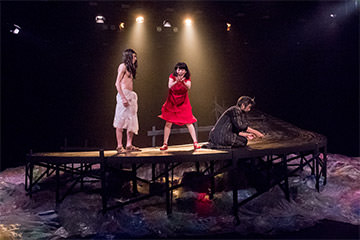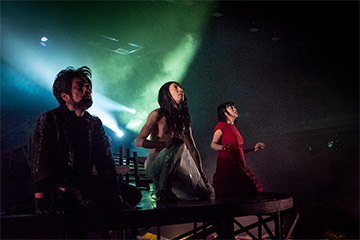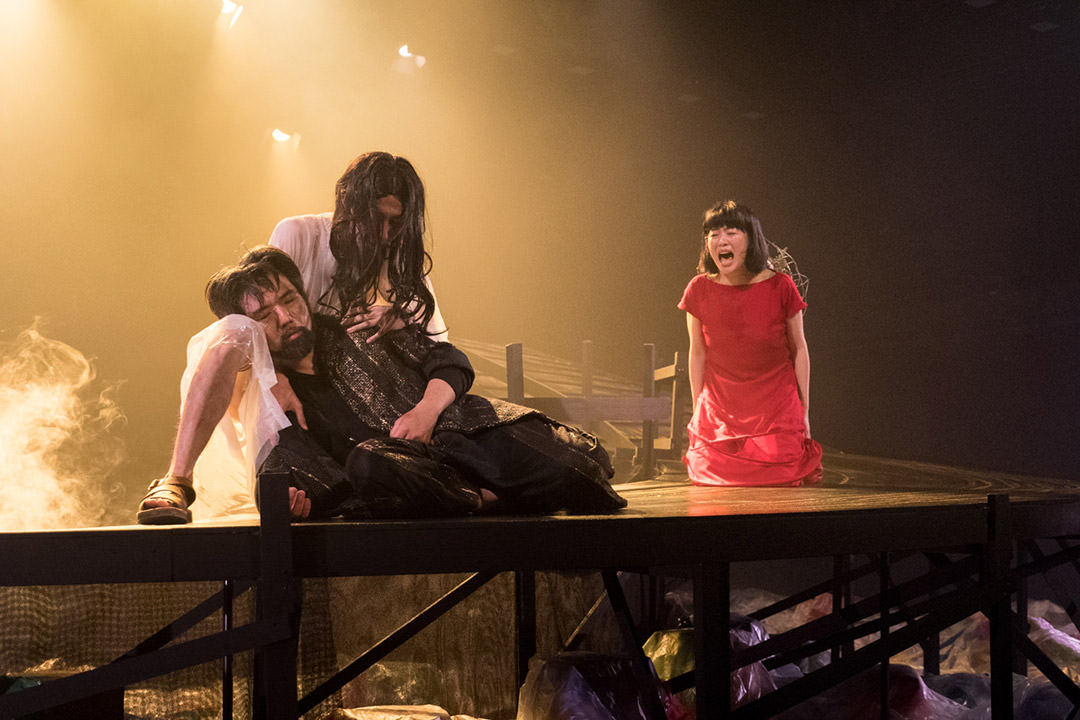
Ode to Joy
© MATSUMOTO Hisaki
Program Information
| Genre / City | Theatre/Aichi, Shizuoka |
|---|---|
| Dates | 28 April at 18:15, 30 April at 18:15 |
| Venue | At Open Air Theatre “UDO”, Shizuoka Performing Arts Park |
| Duration | to be decided (less than 90 minutes) |
| Language | In Japanese with English subtitles |
| seat | Non-reserved seat |
| Directed by | MIYAGI Satoshi |
| Production | Aichi Prefectural Art Theater, SPAC-Shizuoka Performing Arts Center |
Introduction
A fabulous masterpiece of laid-back comedy by KITAMURA So
In this famous, iconic play set in a wasteland amid a nuclear war, a mysterious man called Yasuo appears in front of Gesaku and Kyoko, a couple who are traveling entertainers. Then, even with missiles flying overhead, the three of them are soon having absurdly philosophical conversations in Kansai dialect, performing magic tricks, and entertaining unseen others with farcical songs and dances.
Written in 1979 by the Kishida Drama Award-winning playwright KITAMURA So, Ode to Joy is credited by many critics and scholars with having set the course of the “shogekijou” (small-scale theatre) movement that led the way in Japanese drama through the 1980s. Indeed, the play’s stature is such that it has been performed somewhere in the country almost constantly ever since. This time, MIYAGI Satoshi, SPAC’s artistic director, takes up the challenge of this piece and its unique use of language for the first time, with the internationally renowned artist and set designer KAMIIKE Takuya transforming SPAC’s open-air Theatre UDO in the hills above Shizuoka City into a scene of apocalyptic devastation. Yet for all its dark context, it’s the way this play appears to offer hope even in a world of gloom that’s likely ensured its popularity for all these years.
Director’s Profile
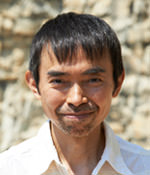
MIYAGI Satoshi
Born in Tokyo in 1959, MIIYAGI is the General Artistic Director of Shizuoka Performing Arts Center (SPAC). After studying aesthetics at Tokyo University under ODASHIMA Yushi, WATANABE Moriaki and HIDAKA Hachiro, he founded the KU NA’ UKA theater company in 1990 and soon began staging plays overseas as well as in Japan. As a result, MIYAGI’s work — in which he often fuses contemporary textual interpretations with physical techniques and patterns of Asian theatre — has long been acclaimed both at home and far beyond. Indeed, in 2004 he received the 3rd Asahi Performing Arts Award, and the next year the 2nd Asahi Beer Art Award.
Since taking up his position with SPAC in April 2007, MIYAGI has staged many of his own works — including Medea, the Hindu epic Mahabharata, and Peer Gynt — and has invited artists from abroad to present pieces casting a keen eye on the modern world as they see it. In line with his aim to make theatre “a window to the world,” he has also started a new SPAC-based project aimed at the youth of Shizuoka.
In July 2014, MIYAGI was invited to the Festival d’Avignon in southern France, where he received excellent reviews for his open-air version of the Hindu epic Mahabharata staged in a huge stone quarry named La Carrière de Bourbon.
Following that landmark achievement, the festival extended the honor of inviting MIYAGI to present a Buddhist interpretation he created of the ancient Greek mythological tragedy Antigone as its super-prestigious opening program for 2017. On that occasion, which was the first time an Asian play had ever been selected to launch the festival, MIYAGI’s exalted “stage” was the open-air Cour d’honneur du Palais des papes (the Honor Court of the Palace of Popes). By the play’s end, those towering medieval stone walls were ringing out with long and splendid standing ovations welcoming the work’s director and creator along with SPAC’s actors and staff — while more than 60 European media all gave great reviews.
Writer’s Profile
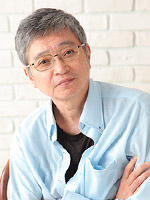
KITAMURA So
Now aged 65, KITAMURA So is one of Japan’s leading playwrights, novelists and essayists. Back in the 1980s, however, he drew lots of attention as a leading figure in this country’s so-called “small-scale theatre movement” with his masterpiece Hogiuta (Ode to Joy) that premiered in 1979 and has been performed continuously as a modern classic since then.
In 1984, KITAMURA won the prestigious 28th Kishida Drama Award with his play 11 Nin no Shonen (Eleven Boys), and followed that in 1990 with the Kinokuniya Theatre Awards for Yuki wo Watatte Dai ni ko Tsuki no Akarusa (Pass over snow: The Second Draft; Moonlight). Since 2013 he has written a new series of original plays based on classic works of Japanese literature. The first of these, titled Goodbye and based on the great novelist DAZAI Osamu’s eponymous unfinished novel, won the 17th Tsuruya Nanboku Drama Award in 2014.
Since 1996, meanwhile, as part of his longstanding effort to foster the talents of young writers, KITAMURA has also delivered lectures at Ai Hall, the public theatre in Itami City, Hyogo Prefecture, in a series titled “So’s private lesson in Itami on how to write a play.”
Related Event
◎Opening ceremony: 28 April, starting 45 minutes before in front of the venue.
Cast / Staff
Directed by MIYAGI Satoshi
Written by KITAMURA So
Set design: KAMIIKE Takuya
Lighting design: KITO Ayumi
Performed by SPAC / OKUNO Akihito, KASUGAI Ippei, TAKII Miki
Lighting operation: HAYASHI Hiroki (A)
Sound design: SASAKI Michihiro (A)
Sound operation: HATTORI Ryuhei (A)
Costume design: KOMAI Yumiko (S)
Assistant Costume designer: KAWAI Reiko (S)
Assistant director: NAKANO Masaki (S)
Visual image: MATSUMOTO Hisaki
Stage manager: SEKOGUCHI Yoshinori (A)
Assistant stage manager: KATO Motoki
Stage: MINE Takeshi (A), NIHEI Haruka (A), KAMIYA Toshiki (S)
Art work: TAKEKOSHI Kanako, SATO Yosuke (S), WATANABE Hiroki (S)
English subtitle translation: MITACHI Riho
Subtitle operation: NAGAI Sayako (S)
Production: ITO Tomomi (A), UEBAYASHI Motoko (A), KOMORI Aya (A), UCHIDA Toshiko (S), YUKIOKA Jun (S), NAKAMURA Yuki (S)
Director of production: YAMAMOTO Mugiko
Technical director: MURAMATSU Atsushi
Lighting manager: HIGUCHI Masayuki
Sound manager: KATO Hisanao
Lighting: FUJITA Takahiro, HISAMATSU Yuka, SATO Karin
Sound: SUGITO Yoshiaki
Volunteers: OCHI Yoshie, TATEBAYASHI Manabu, MATSUMOTO Takanori
Coproducted by Aichi Prefectural Art Theater, SPAC-Shizuoka Performing Arts Center
Produced by Aichi Prefectural Art Theater
Supported by the Agency for Cultural Affairs Government of Japan in the fiscal 2018

(A)・・・Aichi Prefectural Art Theater
(S)・・・SPAC-Shizuoka Performing Arts Center
